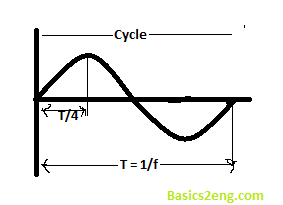EMF equation of Transformers:
A transformer is a static device which has two windings, one is primary winding and other is the secondary winding. When an alternating current is applied to the primary an alternating flux is developed,which links with secondary windings and an emf is induced in the secondary windings according to mutual induction. This magnitude of induced emf can be found using the below emf equation of transformer.
Let N1 = number of turns in primary windings
N2 = number of turns in secondary windings
Φm= Maximum flux in core in webers
= BA
f = frequency of a.c. input in Hz
As shown in the above figure of the EMF equation of transformer, the flux increases from its zero value to maximum value Φm in one-quarter of the cycle i.e. 1/4f second.
Average rate of change flux = Φm/(1/4f)
= 4fΦm
The rate of change of flux per turn means induced e.m.f in volts.
Average e.m.f/turn = 4fΦmvolt
If flux Φm varies sinusoidally, then the r.m.s value of induced e.m.f is obtained by multiplying the average value with the form factor.
Form factor = r.m.s value/average value = 1.11
Now r.m.s value of induced e.m.f in whole of primary = (induced e.m.f/turn)x number of primary turns
E1 = 4.44fN1Φm
E1 = 4.44fN1BA
Similarly, the RMS value of the induced emf in the secondary transformer is
E2 = 4.44fN2BA
It can be observed from above equations that
E1/N1 = E2/N2 = 4.44fΦm
This is the emf equation of the transformer, which means that e.m.f/turn is the same in the primary and secondary windings.
For an ideal transformer on no load, E1 = V1 and E2 = V2.
where V1 = supply voltage of the primary winding
V2 = terminal voltage of secondary winding
Voltage Transformation Ratio(K):
From the equations above we get,
E2/E1 = N2/N1 =k
the constant ‘K’ is called the voltage transformation ratio.
1. If N2>N1 i.e. K>1, then the transformer is called Step up transformer.
2. If N2<N1 i.e. K<1, then the transformer is called Step down transformer.
